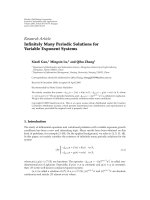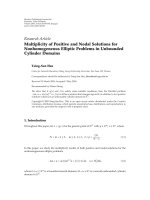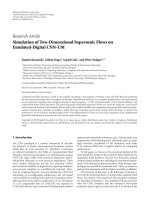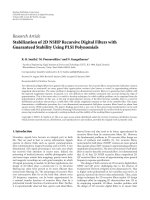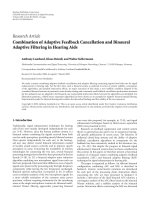Báo cáo hóa học: "Research Article Multiplicity of Positive Periodic Solutions of Singular Semipositone Third-Order Boundary Value " potx
Bạn đang xem bản rút gọn của tài liệu. Xem và tải ngay bản đầy đủ của tài liệu tại đây (493.68 KB, 9 trang )
Hindawi Publishing Corporation
Boundary Value Problems
Volume 2008, Article ID 574842, 9 pages
doi:10.1155/2008/574842
Research Article
Multiplicity of Positive Periodic Solutions of
Singular Semipositone Third-Order Boundary
Value Problems
Yigang Sun
Department of Applied Mathematics, Hohai University, Nanjing 210098, China
Correspondence should be addressed to Yigang Sun,
Received 2 July 2007; Accepted 13 December 2007
Recommended by Colin Rogers
We establish the existence of multiple positive solutions for a singular nonlinear third-order peri-
odic boundary value problem. We are mainly interested in the semipositone case. The proof relies
on a nonlinear alternative principle of Leray-Schauder, together with a truncation technique.
Copyright q 2008 Yigang Sun. This is an open access article distributed under the Creative
Commons Attribution License, which p ermits unrestricted use, distribution, and reproduction in
any medium, provided the original work is properly cited.
1. Introduction
In this paper, we study the existence and multiplicity of positive periodic solutions of the fol-
lowing singular nonlinear third-order periodic boundary value problem:
u
ρ
3
u ft, u, 0 ≤ t ≤ 2π,
u
i
0u
i
2π,i 0, 1, 2.
1.1
Here ρ ∈ 0, 1/
√
3 is a positive constant and ft, u is continuous in t, u and 2π- is periodic
in t. We are mainly interested in the case that ft, u may be singular at u 0 and satisfies the
following semipositone condition:
G
1
There exists a constant L>0 such that Ft, uft, uL ≥ 0 for all t, u ∈ 0, 2π×0, ∞.
During the last two decades, singular periodic problems have deserved the attention
of many researchers 1–8. Third-order boundary value problems have also been studied in
9–11. For the problem 1.1, we recall the following results. In 12, by using Schauder fixed-
point theorem, together with perturbation technique, it was established the existence of at least
one positive solution under some suitable conditions of ft, u. One hard restriction in 12 was
the monotonicity on ft, u.In13, this restricted condition was removed and the existence
2 Boundary Value Problems
of multiple positive solutions was obtained by using the fixed-point index theory. Recently,
instead of Schauder fixed-point theorem and fixed-point index theory, Chu and Zhou 10 em-
ployed a nonlinear alternative principle of Leray-Schauder and a fixed-point theorem in cones
due to Krasnoselskii 14 to study problem 1.1. It was proved that 1.1 has at least two pos-
itive solutions for the positone case and has at least one positive solution for the semipositone
case.
For the convenience of the reader, we recall the following result obtained in 10 for the
semipositone case.
Theorem 1.1. Suppose that (G
1
) is satisfied. Furthermore, it is assumed that
G
2
there exist continuous nonnegative functions gu and hu on 0, ∞ such that
Ft, u ≤ guhu ∀t, u ∈ 0, 2π × 0, ∞1.2
and gu > 0 is nonincreasing and hu/gu is nondecreasing in u;
G
3
there exist continuous, nonnegative functions g
1
u and h
1
u on 0, ∞ such that
Ft, u ≥ g
1
uh
1
u ∀t, u ∈ 0, 2π × 0, ∞1.3
and g
1
u > 0 is nonincreasing and h
1
u/g
1
u is nondecreasing in u;
G
4
there exists r>ρω/σsuch that
r
gσr/ρ − ω
1
hr/ρ − ω/gr/ρ − ω
>
1
ρ
2
, 1.4
where ω L/ρ
3
, σ m/M will be given in Section 2.
G
5
There exists R>rsuch that
R
g
1
R/ρ − ω
1
h
1
σR/ρ − ω/g
1
σR/ρ − ω
≤
1
ρ
2
. 1.5
Then problem 1.1 has a positive solution u with ut > 0 for t ∈ 0, 2π and r/ρ < u ω <R/ρ.
The rest of this paper is organized as follows. In Section 2, some preliminary results will
be given. In Section 3, w e will state and prove the main results. Furthermore, an illustrating
example will be given.
2. Preliminaries
In this section, we present some preliminary results. First, as in 13, we transform the problem
into an integral equation.
For any function u ∈
C0, 2π, we define the operator
Jut
2π
0
gt, xuxdx, 2.1
where
gt, x
⎧
⎪
⎪
⎪
⎨
⎪
⎪
⎪
⎩
e
−ρt−x
1 − e
−2πρ
, 0 ≤ x ≤ t ≤ 2π,
e
−ρ2πt−x
1 − e
−2πρ
, 0 ≤ t ≤ x ≤ 2π.
2.2
Yigang Sun 3
By a direct calculation, w e can easily obtain
2π
0
gt, xdx
1
ρ
. 2.3
Next we consider the equation
u
− ρu
ρ
2
u F
t, J
ut
− ω
, 0 ≤ t ≤ 2π
2.4
with the following periodic boundary condition:
u0u2π,u
0u
2π.
2.5
If ut >L/ρ
2
, for all t ∈ 0, 2π, is a solution of problem 2.4-2.5,itiseasytoverify
that ytJut − ω is a positive solution of problem 1.1for more details, see 10.
Consequently, we will concentrate our study on problem 2.4-2.5.
Lemma 2.1 see 12. The boundary value problem 2.4-2.5 is equivalent to integral equation
ut
2π
0
Gt, sF
s, J
us
− ω
ds,
2.6
where
Gt, s
⎧
⎪
⎪
⎪
⎪
⎪
⎨
⎪
⎪
⎪
⎪
⎪
⎩
2e
ρ/2t−s
sin
√
3/2ρ2π − t se
−ρπ
sin
√
3/2ρt − s
√
3ρ
e
ρπ
e
−ρπ
− 2cos
√
3ρπ
, 0 ≤ s ≤ t ≤ 2π,
2e
ρ/22πt−s
sin
√
3/2ρs − te
−ρπ
sin
√
3/2ρ2π − s t
√
3ρ
e
ρπ
e
−ρπ
− 2cos
√
3ρπ
, 0 ≤ t ≤ s ≤ 2π.
2.7
Moreover, we have the estimates
0 <m
2sin
√
3ρπ
√
3ρ
e
ρπ
1
2
≤ Gt, s ≤
2
√
3ρ sin
√
3ρπ
M, ∀s, t ∈ 0, 2π.
2.8
In applications below, we take X
C0, 2π with the supremum norm · and we define
an operator T : X → X by
Tut
2π
0
Gt, sF
s, Jus
ds, 2.9
where F : 0, 2π ×
R → 0, ∞ is a continuous function. It is easy to see that T is continuous
and completely continuous.
4 Boundary Value Problems
3. Main results
In this section, we state and prove the main results of this paper.
Theorem 3.1. Suppose that ft, u satisfies (G
1
)-(G
5
). In addition, suppose that
G
6
there exists a nonincreasing positive continuous function g
0
u on 0, ∞ and a constant R
0
such that ft, u ≥ g
0
u for t, u ∈ 0, 2π × 0,R
0
,whereg
0
u satisfies the strong force
condition, that is, lim
u→0
g
0
u∞ and lim
x→0
R
0
x
g
0
udu ∞.
Then problem1.1 has at least one positive periodic solution
u with ω<u ω <r/ρ.
Proof. We only need to show that problem 2.4-2.5 has a solution ut >L/ρ
2
and L/ρ
2
<
u <r, for all t ∈ 0, 2π. To do so, we will use the Leray-Schauder alternative principle,
together with a truncation technique.
Let
N
0
{n
0
,n
0
1, },wheren
0
∈ N is chosen such that 1/n
0
<σr− L/ρ
2
and
1
ρ
2
gσr/ρ − ω
1
hr/ρ − ω
gr/ρ − ω
1
n
0
<r.
3.1
For λ ∈ 0, 1, consider the family of equations
u
− ρu
ρ
2
u λF
n
t, J
ut
− ω
ρ
2
n
,n∈
N
0
,
3.2
where
F
n
t, x
⎧
⎪
⎪
⎪
⎨
⎪
⎪
⎪
⎩
Ft, x,x≥
1
nρ
,
F
t,
1
nρ
,x≤
1
nρ
.
3.3
Problem 3.2-2.5 is equivalent to the following fixed-point problem in
C0, 2π:
utλ
2π
0
Gt, sF
n
s, J
us
− ω
ds
1
n
.
3.4
We claim that any fixed point u of 3.4 must satisfy u
/
r for all λ ∈ 0, 1. Otherwise,
assume that u is a solution of 3.4 for some λ ∈ 0, 1 such that u r.Wehave
ut −
1
n
λ
2π
0
Gt, sF
n
s, J
us
− ω
ds
≥ λm
2π
0
F
n
s, J
us
− ω
ds
σMλ
2π
0
F
n
s, J
us
− ω
ds
≥ σmax
t
λ
2π
0
Gt, sF
n
s, J
us
− ω
ds
σ
u −
1
n
.
3.5
Yigang Sun 5
By n, n
0
∈ N
0
, it is evident that 1/n ≤ 1/n
0
<r. Hence, for all t ∈ 0, 2π,wehave
ut ≥ σ
x −
1
n
1
n
≥
1
n
,
ut ≥ σ
x −
1
n
1
n
≥ σ
x−
1
n
1
n
σ
r −
1
n
1
n
≥ σr;
3.6
thus, by conditions G
2
and G
4
,wehave
utλ
2π
0
Gt, sF
n
s, J
us
− ω
ds
1
n
≤
2π
0
Gt, sF
s, J
us
− ω
ds
1
n
≤
2π
0
Gt, sg
J
us
− ω
1
hJus − ω
gJus − ω
ds
1
n
≤
1
ρ
2
gσr/ρ − ω
1
hr/ρ − ω
gr/ρ − ω
1
n
.
3.7
Therefore,
r u≤
1
ρ
2
gσr/ρ − ω
1
hr/ρ − ω
gr/ρ − ω
1
n
0
3.8
which is a contradiction to the choice of n
0
and the claim is proved.
From this claim, the nonlinear alternative of Leray-Schauder guarantees that 3.4 has a
fixed point, denoted by u
n
for n ∈ N
0
with the property u
n
<r.
In order to pass the solutions u
n
of the truncation equation 3.2with λ 1 to that of
the original problem 1.1,weneedthefactu
n
≤H for some constant H>0 for all n ≥ n
0
.
Integrating 3.2 with λ 1 from 0 to 2π,weobtain
ρ
2
2π
0
u
n
tdt
2π
0
F
n
t, J
u
n
t
− ω
ρ
2
n
dt. 3.9
By the periodic boundary condition, u
n
t
0
0 for some t
0
∈ 0, 2π.Then
u
n
max
0≤t≤2π
u
n
t
max
0≤t≤2π
t
t
0
u
n
sds
max
0≤t≤2π
t
t
0
F
n
s, J
u
n
s
− ω
ρ
2
n
ρu
n
s − ρ
2
u
n
s
ds
≤
2π
0
F
n
s, J
u
n
s
− ω
ρ
2
n
ds ρ
2
2π
0
u
n
sds ρ
u
n
t − u
n
t
0
2ρ
2
2π
0
u
n
sds ρ
u
n
t − u
n
t
0
< 4πρ
2
r 2ρr : H.
3.10
6 Boundary Value Problems
In the next lemma, we will show that there exists a constant δ>0 such that
u
n
t −
L
ρ
2
≥ δ, ∀t ∈ 0, 2π
3.11
for n large enough.
Since u
i
n
, i 0, 1 are bounded, {u
n
}
n∈N
0
is bounded and equicontinuous family on
0, 2π. Now the Arzela-Ascoli theorem guarantees that {u
n
}
n∈N
0
has a subsequence, {u
n
}
n∈N
n
k
,
converging uniformly to a function u ∈
C0, 2πobviously, δ ≤ ut ≤ r. Furthermore, u
n
k
satisfies the integral equation
u
n
k
t
2π
0
Gt, sF
s, J
u
n
k
s
− ω
ds
1
n
k
. 3.12
Letting k →∞,weobtainthat
ut
2π
0
Gt, sF
s, J
us
− ω
ds, 3.13
where the uniform continuity of Ft, · on 0, 2π × δ/ρ, r/ρ is used. Hence, ut is a positive
periodic solution of 2.4-2.5.
Finally, it is not difficult to show that u <r,bynotingthatifu r, the argument
similar to the proof of the first claim will yield a contradiction.
Lemma 3.2. There exists a constant δ>0 such that any solution u
n
t satisfies 3.11 for n large
enough.
Proof. The conclusion is established using the strong force condition of ft, u. By condition
G
3
, there exists R
1
∈ 0,R
0
and a continuous function g
0
· satisfying the strong force condi-
tion such that
F
t, J
u
n
t
− ω
−
ρ
2
J
u
n
t
− ω
≥ g
0
J
u
n
t
− ω
> max
L, ρ
2
r ρH
,
3.14
for all t, u ∈ 0, 2π × 0,R
1
.
Choose n
1
∈ N
0
such that 1/n
1
<R
1
and let N
1
{n
1
,n
1
1, }.Forn ∈ N
1
,let
0 <α
n
min
t
u
n
t −
L
ρ
2
≤ max
t
u
n
t −
L
ρ
2
β
n
. 3.15
First we claim that β
n
>R
1
for all n ∈ N
1
. Otherwise, it is easy to verify that
F
n
t, J
u
n
t
− ω
>ρ
2
r ρH.
3.16
Infact,if1/n ≤ u
n
t − L/ρ
2
≤ R
1
, following from 3.14,wehave
F
n
t, J
u
n
t
− ω
F
t, J
u
n
t
− ω
≥ ρ
2
J
u
n
t
− ω
g
0
J
u
n
t
− ω
≥ g
0
J
u
n
t
− ω
>ρ
2
r ρH
3.17
Yigang Sun 7
and if u
n
t − L/ρ
2
≤ 1/n,wehave
F
n
t, J
u
n
t
− ω
F
t,
1
nρ
≥
ρ
n
g
0
1
nρ
≥ g
0
1
nρ
>ρ
2
r ρH. 3.18
By 3.16 and integrating 3.2with λ 1 from0to2π,weobtainthat
0
2π
0
u
n
− ρu
n
ρ
2
u
n
− F
n
t, J
u
n
t
− ω
−
ρ
2
n
dt
≤ ρ
2
2π
0
u
n
tdt −
2π
0
F
n
t, J
u
n
t
− ω
dt < 0.
3.19
This is a contradiction and thus the claim is proved.
Next we claimed that u
n
t > 0, for all t ∈ 0, 2π. Suppose α
n
<R
1
,thatis,
α
n
min
t
u
n
t −
L
ρ
2
u
n
a
n
−
L
ρ
2
<R
1
< max
t
u
n
t −
L
ρ
2
β
n
. 3.20
So there exists c
n
∈ 0, 2πwithout loss of generality, we assume a
n
<c
n
such that u
n
c
n
−
L/ρ
2
R
1
and u
n
t ≤ R
1
L/ρ
2
for t ∈ a
n
,c
n
. It can be checked that
F
n
t, J
u
n
t
− ω
>ρ
2
r ρH.
3.21
By 3.2 with λ 1and3.21, we can easily obtain that u
n
t > 0, as u
0
a
n
0, u
n
t > 0for
all t ∈ a
n
,c
n
, and the function y
n
: u
n
− L/ρ
2
is strictly increasing on a
n
,c
n
. We use ξ
n
to
denote the inverse function of y
n
restricted to a
n
,c
n
.
In order to obtain 3.14, first we will show that
u
n
t −
L
ρ
2
≥
1
nρ
, for some n ∈
N
1
.
3.22
Otherwise, there should exist b
n
∈ a
n
,c
n
such that x
n
b
n
− L/ρ
2
1/n for some n ∈ N
1
and
u
n
t −
L
ρ
2
≤
1
n
, ∀a
n
≤ t ≤ b
n
,
1
n
≤ u
n
t −
L
ρ
2
≤ R
1
, ∀b
n
≤ t ≤ c
n
. 3.23
Multiplying 3.2with λ 1 by u
n
t and integrating from b
n
to c
n
,weobtain
R
1
1/n
F
ξ
n
y,Jy
dy
c
n
b
n
F
t, J
u
n
t
− ω
u
n
tdt
c
n
b
n
F
n
t, J
u
n
t
− ω
u
n
tdt
c
n
b
n
u
n
tu
n
tdt −
c
n
b
n
ρu
n
ρ
2
u
n
−
ρ
2
n
u
n
tdt.
3.24
By the facts u
n
<rand u
n
<H, one can easily obtain that the last equation is bounded,
that is, there exist a constant η>0 such that
R
1
1/n
F
ξ
n
y,Jy
dy ≤ η. 3.25
8 Boundary Value Problems
On the other hand, by G
3
we can choose n
2
∈ N
1
large enough such that
R
1
1/n
F
ξ
n
y,Jy
dy ≥
R
1
1/n
g
0
Jydy > η 3.26
for all n ∈
N
2
{n
2
,n
2
1, }.So3.22 holds for n ∈ N
2
.
As a last step, we will show that 3.14 holds. Multiplying 3.2 by u
n
t and integrating
from a
n
to c
n
,weobtain
R
1
α
n
F
ξ
n
y,Jy
dy
c
n
a
n
F
t, J
u
n
t
− ω
u
n
tdt
c
n
a
n
F
n
t, J
u
n
t
− ω
u
n
tdt
c
n
a
n
u
n
tu
n
tdt −
c
n
a
n
ρu
n
ρ
2
u
n
−
ρ
2
n
u
n
tdt.
3.27
In the same way as in the proof of 3.24, one may readily prove that the right-hand side
of the above equality is bounded. On the other hand, by G
3
if n ∈ N
2
,
R
1
α
n
F
ξ
n
y,Jy
dy ≥
R
1
α
n
g
0
Jydy M
R
1
− α
n
−→ ∞,
α
n
−→ 0
. 3.28
Thus, the claim is confirmed.
Combined with Theorems 1.1 and 3.1, we can obtain the following multiplicity result.
Theorem 3.3. Suppose that (G
1
)–(G
6
) are satisfied. Then problem 1.1 has at least two positive peri-
odic solutions u,
u with ω<u ω <r/ρ<u ω <R/ρ.
Corollary 3.4. Let the nonlinearity in 1.1 be
ft, ubtu
−α
μctu
β
et, 0 ≤ t ≤ 2π,
3.29
where α>0 and β ≥ 0, bt, ct, et are nonnegative continuous functions and bt > 0, for all
t ∈ 0, 2π, μ>0 is a positive parameter. Then
i if β<1,problem1.1 has at least one positive periodic solution for each μ>0;
ii if β ≥ 1,problem1.1 has at least one positive periodic solution for each 0 <μ<μ
∗
,whereμ
∗
is
some positive constant;
iii if β>1,problem1.1 has at least two positive periodic solutions for each 0 <μ<μ
∗
,hereμ
∗
is
the same as in (ii).
Proof. Let M max
0≤t≤2π
|et| and
gub
0
u
−α
,huμc
0
u
β
M, g
1
ub
1
u
−α
,h
1
uμc
1
u
β
, 3.30
where
b
0
max
t
bt > 0,c
0
max
t
ct > 0,b
1
min
t
bt > 0,c
1
min
t
ct > 0. 3.31
Yigang Sun 9
Then conditions G
1
–G
3
and G
5
are satisfied. The existence condition G
4
becomes
μ<
ρ
2
rσr/ρ − ω
α
− Lr/ρ − ω
α
− b
0
c
0
r/ρ − ω
αβ
3.32
for some r > L/ρ
2
σ. Hence, problem 1.1 has at least one positive periodic solution for
0 <μ<μ
∗
: sup
r>0
ρ
2
rσr/ρ − ω
α
− Lr/ρ − ω
α
− b
0
c
0
r/ρ − ω
αβ
. 3.33
Note that μ
∗
∞ if β<1andμ
∗
< ∞ if β ≥ 1. We have the desired results i and ii.
If β>1, then the existence condition G
6
becomes
μ ≥
ρ
2
RR/ρ − ω
α
− b
1
c
1
σR/ρ − ω
αβ
.
3.34
Since β>1, the right-hand side goes to 0 as R →∞.Hence,foranygiven0<μ<μ
∗
,it
is always possible to find such R r that 3.34 is satisfied. Thus, 1.1 has an additional
periodic solution u such that u >r. This implies that iii holds.
References
1 F. Merdivenci Atici and G. Sh. Guseinov, “On the existence of positive solutions for nonlinear differ-
ential equations with periodic boundary conditions,” Journal of Computational and Applied Mathematics,
vol. 132, no. 2, pp. 341–356, 2001.
2 J. Chu and M. Li, “Positive periodic solutions of Hill’s equations with singular nonlinear perturba-
tions,” to appear in Nonlinear Analysis: Theory, Methods & Applications.
3 J. Chu, P. J. Torres, and M. Zhang, “Periodic solutions of second order non-autonomous singular dy-
namical systems,” Journal of Differential Equations, vol. 239, no. 1, pp. 196–212, 2007.
4 M. A. del Pino and R. F. Man
´
asevich, “Infinitely many T-periodic solutions for a problem arising in
nonlinear elasticity,” Journal of Differential Equations, vol. 103, no. 2, pp. 260–277, 1993.
5 D. Jiang, J. Chu, and M. Zhang, “Multiplicity of positive periodic solutions to superlinear repulsive
singular equations,” Journal of Differential Equations, vol. 211, no. 2, pp. 282–302, 2005.
6 A. C. Lazer and S. Solimini, “On periodic solutions of nonlinear differential equations with singulari-
ties,” Proceedings of the American Mathematical Society, vol. 99, no. 1, pp. 109–114, 1987.
7 K. Lan and J. R. L. Webb, “Positive solutions of semilinear differential equations with singularities,”
Journal of Differential Equations, vol. 148, no. 2, pp. 407–421, 1998.
8 J. Wang and D. Jiang, “A singular nonlinear second-order periodic boundary value problem,” The
Tohoku Mathematical Journal, vol. 50, no. 2, pp. 203–210, 1998.
9 A. Cabada, “The method of lower and upper solutions or second, third, fourth and higher order
boundary value problem,” Applied Mathematics and Computation, vol. 40, pp. 135–145, 1990.
10 J. Chu and Z. Zhou, “Positive solutions for singular non-linear third-order periodic boundary value
problems,” Nonlinear Analysis, vol. 64, no. 7, pp. 1528–1542, 2006.
11 D. Jiang and R. P. Agarwal, “A uniqueness and existence theorem for a singular third-order boundary
value problem on 0, ∞,” Applied Mathematics Letters, vol. 15, no. 4, pp. 445–451, 2002.
12 L. Kong, S. Wang, and J. Wang, “Positive solution of a singular nonlinear third-order periodic bound-
ary value problem,” Journal of Computational and Applied Mathematics, vol. 132, no. 2, pp. 247–253,
2001.
13 J. Sun and Y. Liu, “Multiple positive solutions of singular t hird-order periodic boundary value prob-
lem,” Acta Mathematica Scientia. Series B, vol. 25, no. 1, pp. 81–88, 2005.
14 M. A. Krasnosel’ski
˘
ı, Positive Solutions of Operator Equations, P. Noordhoff, Groningen, The Nether-
lands, 1964.




